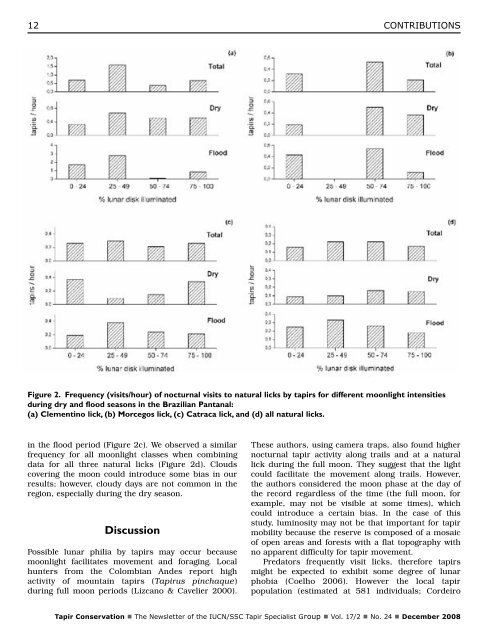Tapir Conservation - Tapir Specialist Group
Tapir Conservation - Tapir Specialist Group
Tapir Conservation - Tapir Specialist Group
Create successful ePaper yourself
Turn your PDF publications into a flip-book with our unique Google optimized e-Paper software.
12 CONTRIBUTIONS<br />
Figure 2. Frequency (visits/hour) of nocturnal visits to natural licks by tapirs for different moonlight intensities<br />
during dry and flood seasons in the Brazilian Pantanal:<br />
(a) Clementino lick, (b) Morcegos lick, (c) Catraca lick, and (d) all natural licks.<br />
in the flood period (Figure 2c). We observed a similar<br />
frequency for all moonlight classes when combining<br />
data for all three natural licks (Figure 2d). Clouds<br />
covering the moon could introduce some bias in our<br />
results; however, cloudy days are not common in the<br />
region, especially during the dry season.<br />
Discussion<br />
Possible lunar philia by tapirs may occur because<br />
moonlight facilitates movement and foraging. Local<br />
hunters from the Colombian Andes report high<br />
activity of mountain tapirs (<strong>Tapir</strong>us pinchaque)<br />
during full moon periods (Lizcano & Cavelier 2000).<br />
These authors, using camera traps, also found higher<br />
nocturnal tapir activity along trails and at a natural<br />
lick during the full moon. They suggest that the light<br />
could facilitate the movement along trails. However,<br />
the authors considered the moon phase at the day of<br />
the record regardless of the time (the full moon, for<br />
example, may not be visible at some times), which<br />
could introduce a certain bias. In the case of this<br />
study, luminosity may not be that important for tapir<br />
mobility because the reserve is composed of a mosaic<br />
of open areas and forests with a flat topography with<br />
no apparent difficulty for tapir movement.<br />
Predators frequently visit licks, therefore tapirs<br />
might be expected to exhibit some degree of lunar<br />
phobia (Coelho 2006). However the local tapir<br />
population (estimated at 581 individuals; Cordeiro<br />
<strong>Tapir</strong> <strong>Conservation</strong> n The Newsletter of the IUCN/SSC <strong>Tapir</strong> <strong>Specialist</strong> <strong>Group</strong> n Vol. 17/2 n No. 24 n December 2008










